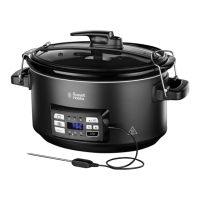7
CONVERTING RECIPES FROM A TRADITIONAL OVEN
These times are approximate and can vary depending on the ingredients and quantities. Always check that the food is
thoroughly cooked before serving.
Oven cooking time Time on low (hours) Time on high (hours)
15-30 minutes 4-6 1-2
30-60 minutes 6-8 2-4
1-3 hours 8-12 4-7
IMPORTANT INFORMATION
• When slow cooking, if there is an interruption to the mains power supply during cooking of 2 hours or less, the
appliance will resume cooking once the power is restored, and continue for the remaining amount of time that has been
programmed. If the power is interrupted for longer than 2 hours the display will ash “----” to indicate that the food
should be discarded. If you are not sure how long the appliance has been o, discard the food.
• Do not add cold food if the cooking pot is hot, and vice versa. The cooking pot material is not meant to handle sudden
changes in temperature.
• Ensure that the lid seal is installed when using the slow cooker. The locking mechanism will not operate properly without
the seal tted.
• When installing the seal make sure that the lip of the seal is facing downwards (g. C).
V
SOUS VIDE FUNCTION
For Sous Vide cooking you will need a bag or pouch to put the ingredients into from which you can remove as much of the air
as possible, and then seal.
Bag/pouch type Advantages Disadvantages
‘Zipper lock’ plastic bag suitable for food Inexpensive ‘Single use’ only
Silicon bag for sous vide cooking
Can be reused
Can be cleaned in a dishwasher
Can be more dicult to remove air
Vacuum pack machine
Creates an almost perfect vacuum and
seals the bag at the same time.
Higher initial cost
Each bag is ‘single use’ only
PREPARATION
Place the ingredients into your chosen bag or pouch. Use one bag per portion. Try to keep portions similar in size. Before
sealing the bag, you need to remove as much air out of it as possible.
For ‘Zipper lock’ style bags:
1. Hand Method (g. D)
Place the bag onto a at surface and, using your hand, carefully push out as much of the air from the bag as you can. Be
careful not to squash or damage the ingredients when you do this. Then, close the seal on the bag.
2. Water Immersion Method (g. E)
Fill a container big enough to hold the zip bag and ingredients with cold water. Put the ingredients into the bag and close the
seal almost all of the way just leaving a small opening at one corner. Slowly push the bag into the water leaving the unsealed
corner sticking up out of the water. When you do this, make sure than no water accidentally enters the bag. As you immerse
the bag, the water will push almost all of the remaining air out. Finally, seal the corner and remove the bag from the container.
For Silicon bags:
Follow the instructions provided by the manufacturer of the bag.
For Vacuum pack machines:
A purpose made vacuum sealer suitable for food use is perfect for sous vide cooking. Use the correct bags as recommended
by the manufacturer, and follow the instructions that come with the machine.
USING THE SOUS VIDE MODE
1. Add hot water and ll the cooking pot to approximately half way. Use water from the hot water tap (not boiling). Try and
get the temperature of the water as close as you can to the temperature you are cooking at as this will cut down any
unnecessary waiting time. Use a mixture of hot and cold water as required. If the water that you put in the cooker is at
a temperature that is very dierent from the temperature you will be cooking at, the appliance will take a lot longer to
either heat the water up or cool it down to the selected temperature.

